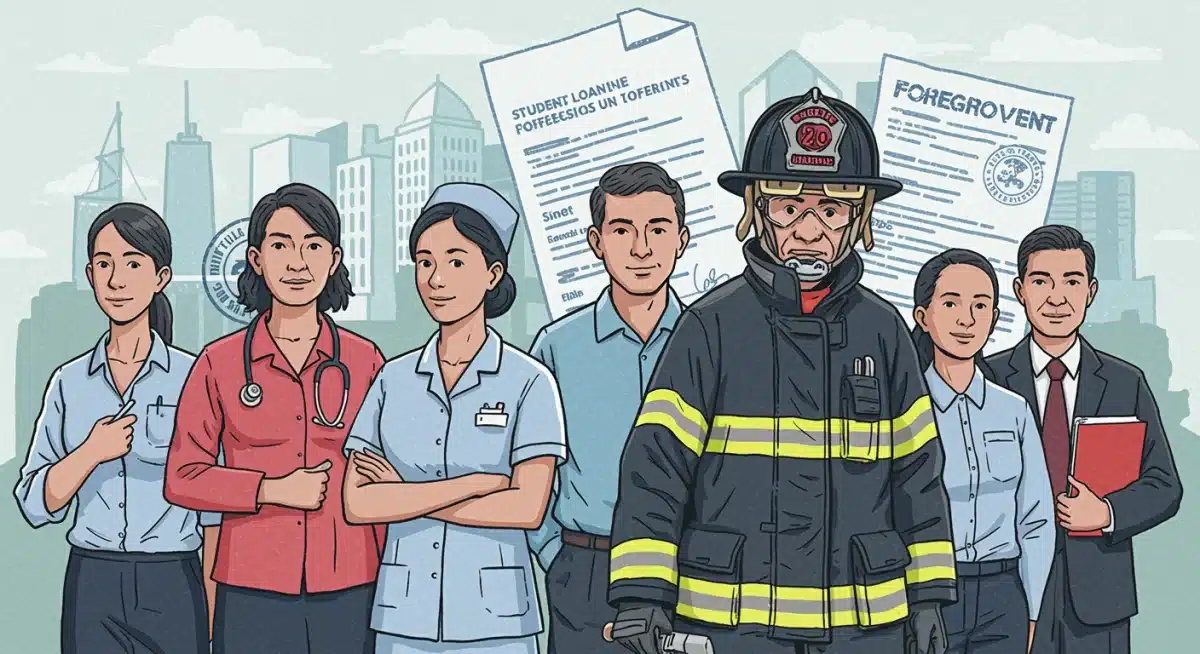Maximizing Student Loan Forgiveness: Your 2025 PSLF Guide

Understanding the 2025 Public Service Loan Forgiveness (PSLF) requirements is crucial for borrowers seeking debt relief, offering a clear path to maximize forgiveness and secure their financial future through dedicated public service.
Navigating the complexities of student loan forgiveness can be daunting, but for those dedicated to public service, the Public Service Loan Forgiveness (PSLF) program offers a beacon of hope. This comprehensive guide will walk you through PSLF 2025 requirements, helping you understand how to maximize your benefits and achieve financial freedom.
Understanding Public Service Loan Forgiveness (PSLF)
The Public Service Loan Forgiveness (PSLF) program was established to encourage individuals to enter and remain in full-time public service employment. It provides a pathway for eligible federal student loan borrowers to have the remainder of their loan balance forgiven after making 120 qualifying monthly payments while working for a qualifying employer. This program can be a life-changer for many, significantly reducing the financial burden associated with higher education.
However, the path to PSLF is not always straightforward. It requires careful planning, consistent adherence to program rules, and diligent record-keeping. Many borrowers encounter challenges, often due to misunderstandings of the eligibility criteria or changes in their employment status. Staying informed about the latest requirements, especially as they evolve, is paramount to successfully navigating the program.
What is PSLF?
- Debt Relief for Public Servants: PSLF is a federal program designed to forgive the remaining balance on Direct Loans for borrowers who work full-time for qualifying public service employers.
- 120 Qualifying Payments: To be eligible, borrowers must make 120 qualifying monthly payments (which do not have to be consecutive).
- Specific Loan Types: Only Direct Loans are eligible. Other federal loan types may become eligible if consolidated into a Direct Consolidation Loan.
The core concept of PSLF is simple: serve your community, and your student loans can be forgiven. Yet, the details can be intricate. Understanding the types of loans, payment plans, and employment that qualify is the first step toward maximizing your chances of forgiveness. This foundational knowledge will empower you to make informed decisions throughout your loan repayment journey.
Eligibility Criteria for PSLF in 2025
For those aiming for PSLF in 2025, understanding the precise eligibility criteria is crucial. The requirements generally revolve around three main pillars: your loan type, your repayment plan, and your employment. Any deviation from these can jeopardize your eligibility, making it essential to review each aspect carefully and regularly.
Changes and clarifications to PSLF rules can occur, so staying updated is not just recommended, it’s mandatory. The Department of Education periodically issues guidance, and keeping abreast of these updates ensures you’re always on the right track. This proactive approach can save you considerable stress and potential setbacks in the future.
Qualifying Loan Types
Only federal Direct Loans are eligible for PSLF. This includes Direct Subsidized Loans, Direct Unsubsidized Loans, Direct PLUS Loans, and Direct Consolidation Loans. If you have other types of federal loans, such as FFEL Program loans or Perkins Loans, you must consolidate them into a Direct Consolidation Loan to make them eligible. It’s important to do this early in your repayment journey, as only payments made after consolidation will count towards the 120-payment requirement.
Qualifying Repayment Plans
To qualify for PSLF, you must be enrolled in an income-driven repayment (IDR) plan. These plans calculate your monthly payment based on your income and family size, making repayment more manageable. Common IDR plans include:
- Saving on a Valuable Education (SAVE) Plan (formerly REPAYE)
- Pay As You Earn (PAYE) Repayment Plan
- Income-Based Repayment (IBR) Plan
- Income-Contingent Repayment (ICR) Plan
Standard Repayment Plan payments also count, but since the loan would be paid off in 10 years under this plan, there would be no balance left to forgive. Therefore, IDR plans are generally the most effective for PSLF.
Qualifying Employment
Your employment must be full-time (at least 30 hours per week) with a qualifying employer. This includes:
- Government organizations at any level (federal, state, local, or tribal)
- Not-for-profit organizations that are tax-exempt under Section 501(c)(3) of the Internal Revenue Code
- Other not-for-profit organizations that provide certain public services
For-profit organizations and political organizations do not qualify. It’s crucial to confirm your employer’s eligibility by submitting the PSLF Employment Certification Form (ECF) annually or whenever you change employers. This form is vital for tracking your progress and ensuring your employment counts.
The Importance of Income-Driven Repayment (IDR) Plans
Income-Driven Repayment (IDR) plans are the cornerstone of successful PSLF pursuit. Without enrolling in one of these plans, borrowers risk making payments that do not count towards the 120-payment requirement, thereby delaying or even disqualifying them from forgiveness. These plans adjust your monthly payment based on your income and family size, ensuring your payments are affordable, especially for those in public service roles that may not always offer high salaries.
Choosing the right IDR plan is a critical decision. Each plan has slightly different formulas for calculating payments and varying terms. Understanding these differences can significantly impact your monthly payments and the amount ultimately forgiven. It is recommended to use the Loan Simulator tool on the Federal Student Aid website to compare plans and determine which one best suits your financial situation.
Key IDR Plans and Their Benefits for PSLF
The SAVE Plan, formerly REPAYE, is often considered one of the most beneficial IDR plans for PSLF, especially for borrowers with lower incomes. It offers a lower monthly payment calculation for undergraduate loans and an interest subsidy that prevents your loan balance from growing due to unpaid interest. Other plans like PAYE and IBR also offer manageable payments and are excellent choices, depending on your specific loan types and financial circumstances.
It’s important to recertify your income and family size annually to ensure your payments remain accurate and affordable. Failing to recertify can lead to higher payments or even temporary disqualification from PSLF-eligible payments. Staying proactive with your IDR plan management is a key strategy for maximizing your loan forgiveness.
Tracking Your Progress: Employment Certification and Payments
Consistent and accurate tracking of your progress is perhaps the most critical administrative task for PSLF. Many borrowers face challenges not because they fail to meet the eligibility criteria, but because they lack proper documentation. The Department of Education relies on specific forms and records to verify your eligibility, and without them, your efforts may go unrecognized.
Submitting the PSLF Employment Certification Form (ECF) regularly is paramount. This form verifies your employment with a qualifying organization and ensures that the payments you’ve made during that period are correctly counted. It’s advisable to submit this form annually or whenever you change employers. This proactive approach helps to catch and correct any discrepancies early on, long before you apply for forgiveness.

Beyond employment certification, maintaining meticulous records of your payments is also essential. While your loan servicer tracks payments, having your own records can serve as a valuable backup in case of discrepancies. This includes keeping statements, payment confirmations, and any correspondence with your loan servicer. Digital copies stored securely are often the most practical.
Steps for Effective Tracking
- Annual ECF Submission: Submit the PSLF Employment Certification Form every year, typically around the same time, and whenever you change jobs.
- Keep Detailed Records: Maintain a personal file with copies of all ECFs, payment confirmations, loan statements, and any communication with your loan servicer or the Department of Education.
- Verify Payment Counts: Regularly check your payment count on your loan servicer’s website. If there are any discrepancies, address them immediately with your servicer.
By diligently tracking your employment and payments, you build a strong case for your PSLF application. This systematic approach minimizes the risk of delays or denials, allowing you to focus on your public service knowing your financial future is on track.
Common Pitfalls and How to Avoid Them
While PSLF offers significant benefits, many borrowers encounter obstacles that can delay or even prevent forgiveness. Understanding these common pitfalls is the first step toward avoiding them and ensuring a smooth path to loan discharge. Proactive planning and attention to detail are your best defenses against these challenges.
One of the most frequent issues arises from misunderstanding qualifying employment. Borrowers often assume their employer qualifies when it does not, or they fail to meet the full-time employment requirement. Another common problem is being on the wrong repayment plan for a period, which means those payments won’t count towards the 120 needed for forgiveness. It is critical to confirm all aspects of your eligibility from the outset and throughout your repayment period.
Avoiding PSLF Disqualifiers
- Incorrect Loan Type: Ensure all your federal loans are Direct Loans. Consolidate any FFEL or Perkins loans early.
- Non-Qualifying Employer: Always verify your employer’s eligibility using the ECF. Don’t assume.
- Wrong Repayment Plan: Enroll in an income-driven repayment plan and recertify annually.
- Not Full-Time Employment: Maintain full-time employment (at least 30 hours per week) with qualifying employers.
- Missing Employment Certification: Submit the ECF annually and whenever you change employers to ensure your payments are tracked correctly.
Another pitfall is simply not knowing where you stand. Many borrowers wait until they believe they have made 120 payments before checking their progress, only to find out there are issues. Regular communication with your loan servicer and consistent review of your payment count can prevent these late-stage surprises. Staying informed and engaged with the process is key to overcoming potential hurdles.
The PSLF Application Process in 2025
Once you believe you have made 120 qualifying payments and met all other eligibility criteria, it’s time to apply for PSLF. The application process itself is relatively straightforward, but it requires careful attention to detail to ensure success. The final application confirms your eligibility and triggers the review process for forgiveness.
The PSLF application, officially known as the PSLF & Temporary Expanded PSLF (TEPSLF) Certification & Application, is the form you will submit to request forgiveness. It requires information about your employment history and confirms that you have met the 120 qualifying payment threshold. It’s essential that all sections are completed accurately and that your employer(s) certify your employment for the relevant periods.
Submitting Your PSLF Application
Before submitting your final application, ensure you have submitted ECFs throughout your repayment period. This helps consolidate your employment and payment history. The application form is available on the Federal Student Aid website. You’ll need to fill out your personal information, employment history, and certify that you meet the full-time employment requirements.
Once submitted, your loan servicer will review your application. This review process can take several weeks or even months, so patience is required. During this time, it’s important to continue making payments if they are due, unless your servicer explicitly tells you otherwise. If your application is approved, your remaining eligible Direct Loan balance will be forgiven, and you will be notified of the successful discharge of your debt.
Maximizing Your PSLF Benefits: Advanced Strategies
Beyond simply meeting the basic requirements, there are advanced strategies borrowers can employ to truly maximize their PSLF benefits and accelerate their path to forgiveness. These strategies often involve a deeper understanding of the program’s nuances and proactive financial planning. Thinking strategically about your loan management can lead to significant savings and faster debt relief.
One such strategy involves understanding the nuances of payment timing. While 120 payments are required, there are specific circumstances where lump-sum payments or payments made outside the typical monthly schedule can be optimized. However, it’s critical to consult with your loan servicer or a financial aid expert before implementing any unconventional payment strategies to ensure they will count towards PSLF.
Strategic Approaches for Greater Forgiveness
Consider filing taxes separately if you are married and both you and your spouse have federal student loans. This can sometimes result in a lower calculated income for your IDR plan, leading to lower monthly payments and a larger amount to be forgiven. However, this decision should be made in consultation with a tax professional, as it can have other tax implications.
Another strategy is to be mindful of your income trajectory. If you anticipate a significant increase in income, planning to make more PSLF-qualifying payments before that increase can be beneficial. Lower payments made on a lower income mean more of your original balance remains to be forgiven. Conversely, if your income decreases, promptly recertifying your IDR plan can lower your monthly payments, helping you continue to make qualifying payments without financial strain.
Finally, always stay informed about any legislative changes or temporary waivers that may impact PSLF. Historically, there have been limited-time opportunities, such as the PSLF Waiver, that allowed previously ineligible payments to count. Being aware of and acting on these opportunities can significantly accelerate your forgiveness timeline. Proactive engagement with available resources and staying updated on policy changes are key to maximizing your PSLF journey.
| Key Aspect | Description |
|---|---|
| Qualifying Loans | Only Federal Direct Loans are eligible. Consolidate other federal loans if needed. |
| Qualifying Employment | Full-time for government or eligible 501(c)(3) non-profits. |
| Repayment Plan | Must be on an Income-Driven Repayment (IDR) plan. |
| Tracking Progress | Submit Employment Certification Forms (ECF) annually and keep detailed records. |
Frequently Asked Questions About PSLF
Only Federal Direct Loans are eligible for PSLF. This includes Direct Subsidized, Unsubsidized, PLUS, and Consolidation Loans. If you have other federal loan types, such as FFEL or Perkins, you must consolidate them into a Direct Consolidation Loan to make them eligible. Payments made before consolidation do not count.
Qualifying employers include government organizations at any level (federal, state, local, tribal) and not-for-profit organizations that are tax-exempt under Section 501(c)(3) of the Internal Revenue Code. You should submit the PSLF Employment Certification Form (ECF) annually or whenever you change jobs to verify your employer’s eligibility.
Yes, to qualify for PSLF, you must be enrolled in an income-driven repayment (IDR) plan. These plans include the SAVE Plan, PAYE, IBR, and ICR. While the Standard Repayment Plan also counts, it typically pays off your loan before forgiveness is possible. IDR plans ensure eligible payments are made and a balance remains for forgiveness.
You must make 120 qualifying monthly payments to receive PSLF. These payments do not need to be consecutive, but they must be made while you are employed full-time by a qualifying employer and enrolled in an eligible repayment plan. Each payment must be made on time and for the full amount due.
If you change jobs, you should submit a new PSLF Employment Certification Form (ECF) for your previous employer and an ECF for your new employer as soon as possible. This ensures your employment periods are correctly certified and your qualifying payments are accurately tracked. Ensure your new employer also qualifies for PSLF.
Conclusion
The Public Service Loan Forgiveness program remains a powerful tool for individuals dedicated to public service, offering a clear path to significant student loan debt relief. By understanding and diligently adhering to the PSLF 2025 requirements, borrowers can confidently navigate the process. From ensuring eligible loan types and repayment plans to meticulous tracking of employment and payments, every step is crucial. Proactive engagement, continuous education on program updates, and strategic planning are the keys to unlocking the full potential of PSLF, ultimately empowering public servants to focus on their vital work without the overwhelming burden of student debt.





